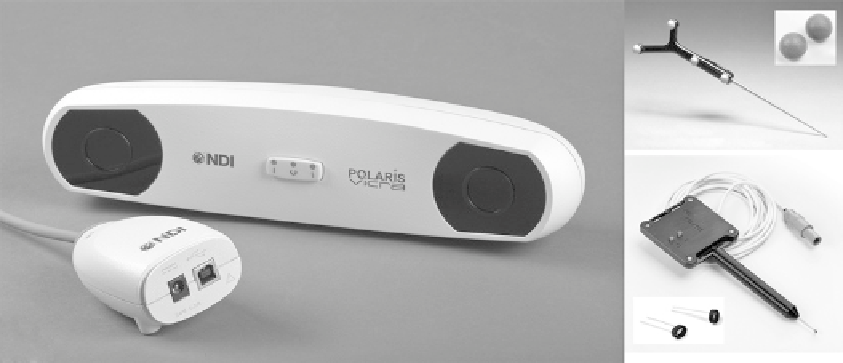Biomedical Engineering Reference
In-Depth Information
instrument to be tracked. This is not always convenient and,
furthermore, precludes tracking of flexible instruments inside
the body. Electromagnetic tracking systems, refined for clinical
use over the past five years, have no line-of-sight limitations and
can track instruments such as catheters and the tips of needles
inside the body. The choice of tracking system is highly appli-
cation dependent and requires an understanding of the desired
working volume and accuracy constraints.
Optical tracking systems can be characterized as passive
or active depending on the type of markers used. While both
varieties use infrared (IR) light to localize markers, the differ-
ence lies in the method used. Passive varieties use retroreflec-
tive spheres as markers with the tracking camera acting as the
source and detector of IR light. Light emitted from the tracker
camera is reflected off the passive markers and detected at the
camera to triangulate marker location. Active varieties use
IR light-emitting diodes as the marker with the tracker cam-
era acting only as a detector to localize the markers. Northern
Digital Inc. (NDI) is a manufacturer of both passive and active
marker tracking devices that have been used in medical appli-
cations. Other forms of passive tracking include videometric
camera units that track the position of pattern-marked tools in
video image sequences, as exemplified by the MicronTracker
system from Claron Technology Inc. These active IR, passive
IR, and videometric trackers are shown in Figure 12.2. While
optical tracking systems offer high measurement accuracy in
a relatively large workspace, they do have line-of-sight limita-
tions, whereby valid position tracking is only possible as long
as no occlusions occur between the tracker camera and tracked
tools. In a congested operating environment and in interven-
tional radiology applications, the line-of-sight limitation can be
cumbersome.
Passive probe
(inset: retro-reflective spherical markers)
(a)
Active probe
(inset: IR LED markers)
(b)
FIGURE 12.2
Commonly used optical tracking technologies: (a) NDI Vicra IR-based tracker camera, also shown: (top-right inset) passive probe
with retroreflective markers and (bottom-right inset) active probe with active IR LED markers (With permission, © 2011 Northern Digital Inc.);
(b) Claron MicronTracker videometric tracker with pattern-marked markers. (With permission, © 2011 Claron Technology Inc.)


